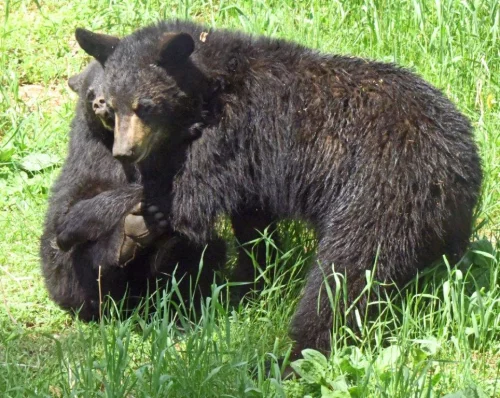Heartwarming Sounds and Scenes - UPDATE June 1, 2023

Paul and his buddy
For over two weeks, a lone yearling has been here daily, behaving cautiously and taking refuge high up in a white pine as yearlings often do when they are newly on their own after family breakup. The team has identified him as Paul, son of 8-year-old Pixie who has been seen repeatedly 3 miles north of here before and after family breakup.
New yearling
New yearling

Today, life changed for Paul. For the past few days another yearling has been coming. Today, they made ‘Ted sounds’ to each other, tentatively coming together and backing off, only to make sweet sounds again and finally touching noses. Things progressed rapidly from there. One climbed a tree. The other followed. After some tentative play, they both got on the same level in the tree and played raucously. They are still together now at 8 PM.

Paul climing to buddy Paul and buddy Paul and buddy
Paul climbs to his buddy to play


Their play included the larger one (117 pounds) lying on his back while Paul (88 pounds) got on him and played like little cub Lucky used to get on big Ted.
Play looks a lot like fighting but is done quietly with gentle bites. Their ears are often back but spread to the sides in what some call ‘airplane ears’ that are common during play. It’s all gentle but sometimes fast.Paul (open mouth) and buddy
Paul (open mouth) and buddy

These two yearlings did not argue over food. They got on the scale tight together and ate nose to nose. They both seemed to need each other. They were inseparable. As they played in a lying down position, they sometimes relaxed with one on top of the other. It is common for yearlings to buddy up, but this is the first time I saw the initial actions and sounds of two yearlings sealing their friendship.
We’ll see what they do tomorrow, how many days or weeks they stay together, and if other yearlings join them over the next several weeks. I’ve seen groups of up to four. We’ll be watching.
Thank you for all you do,
Lynn Rogers, Biologist, Wildlife Research Institute and North American Bear Center

 Author
Topic: Jewel and her cubs (Read 2320856 times)
Author
Topic: Jewel and her cubs (Read 2320856 times)
